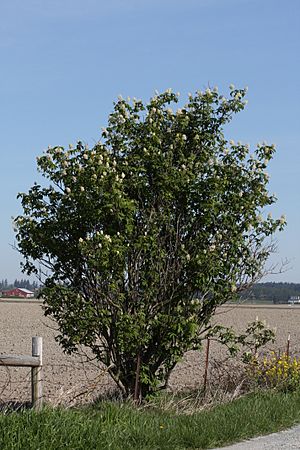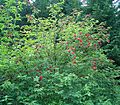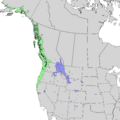Red elderberry facts for kids
Quick facts for kids Red elderberry |
|
|---|---|
 |
|
| Scientific classification | |
| Genus: |
Sambucus
|
| Species: |
racemosa
|
| Subspecies | |
|
|
Sambucus racemosa is a type of elderberry plant. It is often called red elderberry or red-berried elder because of its bright red fruits. This plant is found in many parts of the world.
Contents
Where Red Elderberry Grows
Red elderberry plants grow naturally in Europe, northern Asia, and North America. You can find them across Canada and the United States. They like to grow in places near water, like riverbanks, and in woodlands. They usually prefer areas that are moist.
What Does Red Elderberry Look Like?
The red elderberry is usually a shrub that looks like a small tree. It can grow between 2 and 6 meters (about 6 to 20 feet) tall. Its stems are soft and have a spongy center called a pith.
Leaves and Flowers
Each leaf on a red elderberry plant is made up of 5 to 7 smaller leaflets. These leaflets can be up to 16 centimeters (about 6 inches) long. They are shaped like a spear or a narrow oval and have jagged edges. If you crush the leaves, they have a strong, unpleasant smell.
The flowers grow in a cluster that looks a bit like a cone. When the flower buds are closed, they are pink. When they open, the flowers are white, cream, or yellowish. Each flower has small petals that curve backward. They also have five white parts called stamens with yellow tips. The flowers smell nice and attract hummingbirds and butterflies.
Fruits
The fruit of the red elderberry is a bright red, or sometimes purple, berry. It's actually a type of fruit called a drupe, which means it has a hard pit inside. Each berry usually contains 3 to 5 small seeds.
Different Kinds of Red Elderberry
There are several different types, or subspecies, of Sambucus racemosa. These include:
- Sambucus racemosa subsp. kamtschatica: This type is found in Northeastern Asia.
- Sambucus racemosa var. melanocarpa: Known as the Rocky Mountain elder, it grows in the Western United States and Western Canada.
- Sambucus racemosa subsp. pubens: This is the American red elder, found in Eastern North America.
- Sambucus racemosa subsp. racemosa: This is the European red elder.
- Sambucus racemosa subsp. sibirica: This type grows in Siberia.
- Sambucus racemosa subsp. sieboldiana: This is the Japanese red elder.
Uses of Red Elderberry
It's important to know that the stems, roots, and leaves of the red elderberry plant are not safe to eat. The raw berries can also make you feel sick or be harmful if eaten.
Traditional Uses
Native American groups, like the Bella Coola and Ojibwa peoples, used red elderberry as a traditional medicinal plant. They used it for many things, such as helping with colds and coughs, stomach problems, and to stop bleeding.
Food and Wildlife
While the raw berries can be unsafe, the fruits are reportedly safe to eat when they are cooked. Native American tribes, including the Apache and Yurok peoples, cooked the berries in various recipes.
Birds really enjoy eating the fruits, and they help spread the seeds to new places. The flowers are also a great source of nectar for butterflies and hummingbirds.
Growing Red Elderberry
Sambucus racemosa is also grown as an ornamental plant in gardens. People plant it as a shrub or small tree in their yards. It's also used in natural landscape designs to attract wildlife.
Popular Types for Gardens
Some special types of red elderberry that gardeners like to grow include:
- Sambucus racemosa 'Black Lace': This one has dark, burgundy-colored leaves.
- Sambucus racemosa 'Lemon Lace': Its leaves are a mix of golden yellow and green.
- Sambucus racemosa 'Lemony Lace': This type has golden-green leaves, and new growth is red.
- Sambucus racemosa 'Sutherland Gold': This plant has green leaves, and its new leaves are bronze. It even won an award from the Royal Horticultural Society!
Images for kids
See also
 In Spanish: Saúco rojo para niños
In Spanish: Saúco rojo para niños






